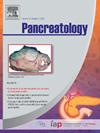胰腺空肠吻合术技术改进后,胰瘘发生率降低:一项单中心研究。
IF 2.7
2区 医学
Q2 GASTROENTEROLOGY & HEPATOLOGY
引用次数: 0
摘要
目的:本研究比较了胰十二指肠切除术后标准内陷式胰空肠吻合术(PJ)和改良PJ技术的术后胰瘘(POPF)发生率,并评估了改良PJ术的临床实用性:回顾性分析2018年2月至2021年10月在苏州大学附属第一医院接受胰十二指肠切除术的363例患者的临床和术后数据。在我们的队列中,155 名患者接受了改良 PJ 技术(A 组),208 名患者接受了标准内陷 PJ 技术(B 组)。我们收集并分析了人口统计学特征、病理性质、术中因素和术后并发症(包括 POPF)等数据:结果:人口统计学特征在组间无明显差异(P > 0.05)。在所有组别中,改良 PJ 技术与临床相关的 POPF(CR-POPF)发生率显著降低相关(11.6% 对 26.4%,P 结论:改良 PJ 技术与临床相关的 POPF 发生率显著降低相关(11.6% 对 26.4%,P 结论):改良的内陷 PJ 技术降低了 CR-POPF 的发生率,并改善了预后。本文章由计算机程序翻译,如有差异,请以英文原文为准。
An improved invagination pancreaticojejunostomy technique associated with a lower incidence of pancreatic fistula: A single-center study
Purpose
This study compared the incidence of postoperative pancreatic fistula (POPF) between standard invagination pancreaticojejunostomy (PJ) and an improved PJ technique after pancreaticoduodenectomy and evaluated the clinical utility of the improved PJ procedure.
Methods
Clinical and postoperative data of 363 patients who underwent pancreaticoduodenectomy at the First Affiliated Hospital of Soochow University from February 2018 to October 2021 were analyzed retrospectively. In our cohort, 155 patients underwent the improved PJ technique (group A), and 208 underwent standard invagination PJ (group B). Data on demographic characteristics, pathological nature, intraoperative factors, and postoperative complications, including POPF, were collected and analyzed.
Results
There were no significant between-group differences in demographic characteristics (p > 0.05). The improved PJ technique was associated with a significantly lower incidence of clinically relevant POPF (CR-POPF) in the total cohort (11.6 % vs. 26.4 %, p < 0.001) and in the subgroup with high fistula risk scores (16.0 % vs. 38.6 %, p < 0.001).
Conclusion
The improved invagination PJ technique reduces the incidence of CR-POPF and improves prognosis.
求助全文
通过发布文献求助,成功后即可免费获取论文全文。
去求助
来源期刊

Pancreatology
医学-胃肠肝病学
CiteScore
7.20
自引率
5.60%
发文量
194
审稿时长
44 days
期刊介绍:
Pancreatology is the official journal of the International Association of Pancreatology (IAP), the European Pancreatic Club (EPC) and several national societies and study groups around the world. Dedicated to the understanding and treatment of exocrine as well as endocrine pancreatic disease, this multidisciplinary periodical publishes original basic, translational and clinical pancreatic research from a range of fields including gastroenterology, oncology, surgery, pharmacology, cellular and molecular biology as well as endocrinology, immunology and epidemiology. Readers can expect to gain new insights into pancreatic physiology and into the pathogenesis, diagnosis, therapeutic approaches and prognosis of pancreatic diseases. The journal features original articles, case reports, consensus guidelines and topical, cutting edge reviews, thus representing a source of valuable, novel information for clinical and basic researchers alike.
 求助内容:
求助内容: 应助结果提醒方式:
应助结果提醒方式:


